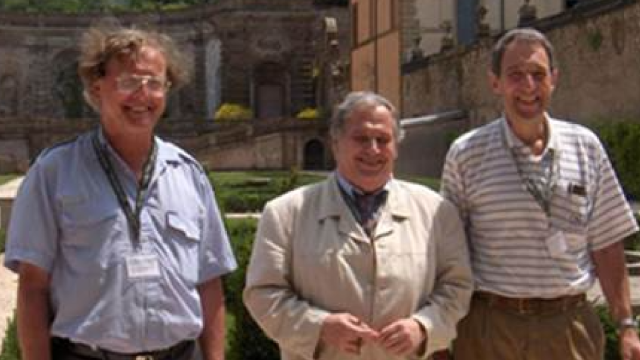Physicists Sergio Ferrara, Dan Freedman, and Peter van Nieuwenhuizen will split a $US3 ($4) million Breakthrough Prize for their theory of supergravity, which drives much of today’s physics research toward our understanding of the universe.
The Breakthrough Prize is an annual award to recognise groundbreaking science, funded by Russian-Israeli billionaire Yuri Milner. Though Breakthrough Prizes are awarded annually, “special” Breakthrough Prizes can be awarded any time and need not honour recent work. In fact, the researchers behind today’s award thought they’d missed the chance to win it.
“I was absolutely, totally speechless,” Van Nieuwenhuizen told Gizmodo. “For many years we had believed we were in the running for the prize, but each year other really good people got it. I had given up hope completely, but then I got the phone call telling me I had gotten it. It was a total surprise.”
Today, one of physics’ biggest problems is that the behaviours of the smallest particles can be explained by the theories of quantum mechanics and quantum field theory, but they don’t make sense when you apply the theory that governs gravity and the most massive objects, called general relativity. Physicists had basically ended up with a whole lot of infinities in their theories that they couldn’t get rid of. Other attempts to unify the fundamental forces the universe ended up calculating numbers far too large for what experiments were actually observing for some of the forces.
Supergravity was one way to reconcile these issues that seemed to work. Back in the 1960s and 70s, scientists tried to fix other particle physics problems with “supersymmetry,” which proposed that each existing matter particle (like quarks or electrons) had a corresponding force particle, and each existing force particle (like photons) had a corresponding matter particle. The theory also provided a candidate for dark matter, a mysterious substance that seems to make up most of the universe’s mass but hasn’t been observed yet.
Supergravity, which these physicists devised in 1976, offered a way to include gravity in the supersymmetric picture, as well as a way to unify quantum physics with general relativity. It proposed the existence of a “gravitino,” a supersymmetric partner to the “graviton,” a theorised particle whose behaviour would govern the force of gravity. Supergravity became an influential theory, one that has appeared in many iterations of string theory.
“Supergravity is a remarkable construction that extends Einstein’s theory of gravity to include quantum variables in the structure of spacetime. Supergravity has been extraordinarily important in many later developments,” Edward Witten, an influential theoretical physicist at the Institute for Advanced Study in New Jersey who has also won a Breakthrough Prize, told Gizmodo in an email.
Supergravity and other supersymmetric theories have begun to fall out of favour with some physicists, though. Particle accelerators have so far failed to find any evidence of supersymmetric particles — the lightest of which have been predicted to show up by now.
“Supergravity is an interesting attempt at a unified theory, but all evidence (including experimental results from the Large Hadron Collider) is that it doesn’t work,” Columbia University theoretical physicist and string theory critic Peter Woit told Gizmodo in an email. “I don’t understand the choice to award a large prize for theoretical work that has not succeeded at explaining anything about nature.”
Unlike the Nobel Prize, the Breakthrough Prize can be awarded to influential theoretical work that hasn’t been proven — string theory has won the award several times.
Van Nieuwenhuizen told Gizmodo that even if supersymmetric particles go undiscovered, he felt that supergravity will remain an important piece of mathematical work — a tool and framework to better understand theoretical mathematics.
“I think, if I may say so, it is an absolutely beautiful piece of work as it stands. It’s complete and a beautiful extension of Einstein’s theory of general relativity. How it will be evaluated in the future, whether just a tool or a physical reality, that remains to be seen.”
The Breakthrough Prize was founded by Sergey Brin, Anne Wojcicki, Mark Zuckerberg, Priscilla Chan, Yuri Milner, Julia Milner, Jack Ma, and Pony Ma. Aside from the special prize, annual prizes go to mathematics, fundamental physics, and life sciences.
Just a year ago, the selection committee awarded another special prize to Jocelyn Bell Burnell for her underappreciated work on the discovery of pulsars.
